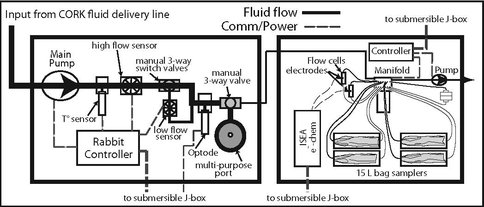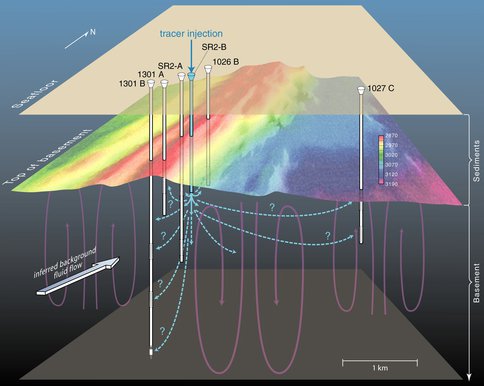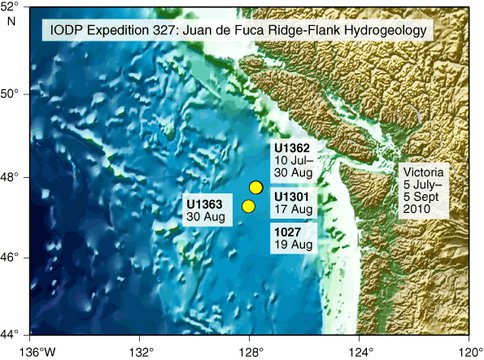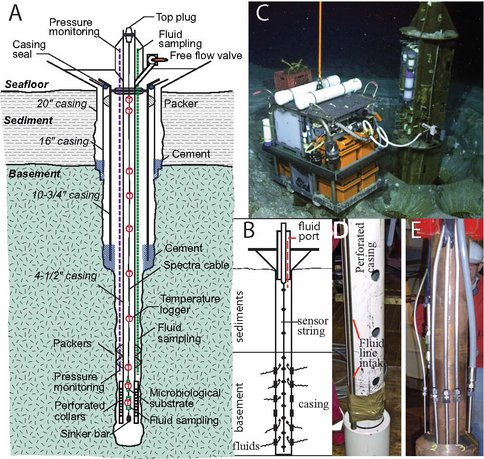2011 Annual Science Report
 University of Hawaii, Manoa
Reporting | SEP 2010 – AUG 2011
University of Hawaii, Manoa
Reporting | SEP 2010 – AUG 2011
Deep (Sediment-Buried Basement) Biosphere
Project Summary
The ocean crust comprises the largest aquifer on earth. Deep sediment cover provides an environ-ment for a unique biosphere hosting microorganisms surviving under extreme conditions. Frac-tured rock provides abundant surfaces that can be colonized by diverse microbes and water-rock reactions promote chemical conditions that influence key geochemical cycles within the Earth’s crust and oceans. Team members participated in a 14-day research cruise to study the sediment-buried basement (basaltic crust) biosphere, to provide unprecedented and unique insight into the mobility and origin of microorganisms within this remote biosphere.
Project Progress
Project personnel participated in a research cruise on the Integrated Ocean Drilling Program’s drill ship (Joides Resolution) during Aug-Sep. 2010 and another 14 day research cruise during June 2011 using the ship R/V Atlantis and the remotely operated vehicle (ROV) Jason; both cruises were to study the sediment-buried basement (basaltic crust) biosphere. Participants on the June 2011 cruise included 3 NAI team members (including NAI postdoctoral fellow, Alberto Robador), 2 gradu-ate students and a middle school teacher from the island of Hawaii, serving underrepresented Ha-waiian and Pacific Islander families. This project utilized the long-term ODP borehole ‘CORK’ obser-vatories to collect clean samples of crustal fluids for geochemical, microbiological and ecological characterization (Fig. 1). Because water-rock reactions and associated microbial habitats vary with crustal temperature and age, we are comparing the geochemistry and molecular diversity in crustal fluids from multiple borehole observatories on the flanks of the Juan de Fuca Ridge (JFR), ranging in basement age (~1.24 to 3.5 my) and in basement temperature (~38° to ~65°C).
In support of these microbial geochemical studies, we have been developing an increasingly ca-pable suite of instruments for extracting, analyzing and sampling large volumes of fluids from the basement environment. An upgraded sampling system (Fig. 2) used during the summer 2011 cruise permitted the collection of large volumes of the most pristine fluids ever collected from the basaltic crust. We now have 4 years of time series geochemical and molecular biological data from this en-vironment.
We have also made substantial progress towards the characterization of microbial respiration activity in deep sub-seafloor habitats and the development of a high-pressure thermal gradient sys-tem to study the pressure and temperature response of microbial metabolism. A current prototype of the incubation device was already used during the past two cruises to the Juan de Fuca Ridge Flanks (2010 and 2011) and it is on a final developmental stage. Potential rates of sulfate reduction were detected in hydrothermal fluids from the upper ocean crust on the Juan de Fuca Ridge flanks and the physiological characterization of microorganisms as a function of temperature in the base-ment fluids revealed the coexistence of different sulfate reducing populations in the mesophilic to thermophilic range. Together, these observations confirm that basement fluids support microbial sulfate reduction and underscore the temperature control on the metabolic reactions and microbial community distribution in the upper basement’
An existing fluid sampling and sensor instrument (the GeoMICROBE) sled was substantially up-graded over the past year in anticipation for our summer 2010 research cruise to the Juan de Fuca Ridge flank (see 2010 Annual Report for brief description). The sled was recovered after a success-ful year-long deployment (Fig. 3) (Deployed June 2010 to CORK at U1301A), refurbished and then redeployed for another one-year deployment at a new CORK observatory (U1362A) on the Juan de Fuca Ridge flanks. We have completed fabrication of two out of three new GeoMICROBE sleds, with significant improvements, for the North Pond (flanks of the northern Mid-Atlantic Ridge) CORK ob-servatories to be installed during November, 2011.
Another component of our Deep Biosphere Project involves the establishment of a three-dimensional, subseafloor, IODP observatory network in the northeastern Pacific Ocean, for initiation of a large-scale, large-term cross-hole experiments (Fig. 4). As noted above during this years ROV cruise to the Juan de Fuca Ridge flank CORKs we were able recover the GeoMICROBE sled and other long-term (1 year) samplers (OsmoSamplers) with which we have been monitoring the transport of a suite of dissolved and colloid (fluorescent microspheres and fluorescently stained bacteria) in-jected into the deep sediment-buried basement during summer 2010. The colloid tracers represent proxies for microorganisms and their recover at monitoring holes should provide unprecedented insight into the mobility and origin of microorganisms within this remote biosphere. Analyses of these samples for evidence of tracer break through is underway.
Flow diagram of Mobile Pump System (MPS) coupled to a Medium Volume Bag Sample system. MPS can also be coupled to multiple Large Volume Bag Samplers or other samplers via the multi-purpose port.
Selected results of GeoMICROBE 12 month deployment data. Time-series data for temperature (SBE11) of fluids down-stream of primary pump, primary pump speed, battery voltage and current draw for overall system. Note that time axis is discontinuous, with the month long ‘rest’ periods re-moved.
Cartoon depicting the tracer transport project, showing a single injection borehole and multiple monitoring boreholes. The sediments provide a featureless seafloor that hides the relatively higher relief of the buried basement.
Site for the expeditions to the CORK observatories.
Schematic drawings of modified CORK-II (a) and original CORK designs (b), the former showing continuous fluid delivery lines (FDL) extending from basement to seafloor platform (dashed green lines) (from Wheat et al. 2011). Photographs of© GeoMICROBE instrument sled connected to CORK-II installation at IODP Hole 1301A, (d) FDL intake screen at exterior of base of epoxy-coated CORK casing and (e) 4 stainless steel and one Tefzel (on right) FDLs attached to exterior of CORK casing in preparation for installation.
Publications
-
Cowen, J. P., Copson, D. A., Jolly, J., Hsieh, C-C., Lin, H-T., Glazer, B. T., & Geoffrey Wheat, C. (2012). Advanced instrument system for real-time and time-series microbial geochemical sampling of the deep (basaltic) crustal biosphere. Deep Sea Research Part I: Oceanographic Research Papers, 61, 43–56. doi:10.1016/j.dsr.2011.11.004
-
Fisher, A. T., Cowen, J., Wheat, C. G., & Clark, J. F. (2011). Preparation and injection of fluid tracers during IODP Expedition 327, eastern flank of Juan de Fuca Ridge. Proceedings of the IODP. doi:10.2204/iodp.proc.327.108.2011
- Boettger, J., Amend, J.P., Henscher, M., Lin, H. & Cowen, J.P. (In preparation). Energetics of microbial metabolism in the subseafloor basement ecosystem at the Juan de Fuca Ridge.
- Fisher, A., Cowen, T., Wheat, J., Geoffrey, C. & Clark, J.F. (2011). Preparation and Injection of Fluid Tracers during IODP Expedition 327, Eastern Flank of the Juan de Fuca Ridge. In: A. T. Fisher, T.T.a.K.P. (Eds.). Proc. IODP. Vol. 327. College Station, TX: Integrated Ocean Drilling Program.
- Fisher, A.T., Wheat, C.G., Becker, K., Cowen, J., Orcutt, B., Hulme, S., Inderbitzen, K., Turner, A., Pettigrew, Davis, E.E., Jannasch, H., Grigar, K., Aduddel, R., Meldrum, R., MacDonald, R. & Edwards, K. (2011). Design, Deployment, and Status of Borehole Observatory Systems used for Single-Hole and Cross-Hole Experiments, IODP Expedition 327, Eastern Flank of the Juan de Fuca Ridge. In: A. T. Fisher, T.T.a.K.P. (Eds.). Proc. IODP. Vol. 327. College Station, TX: Integrated Ocean Drilling Program.
- Jungbluth, S., Cowen, J. & Rappé, M. (Submitted). Phylogenetic diversity of microorganisms inhabiting basement fluids of the deep subseafloor basaltic crust accessed through ODP boreholes 1025C and 1026B along Juan de Fuca Ridge flank. Frontiers in Extreme Microbiology.
- Jungbluth, S., Grote, J., Lin, H., Cowen, J. & Rappé, M. (Submitted). Microbial diversity in subseafloor crustal fluids. ISME Journal.
- Lin, H., Cowen, J.P., Olson, E., Amend, J.P. & Lilley, M.D. (Accepted). Inorganic chemistry, gas compositions and dissolved organic carbon of discrete samples from sedimented young basement in Juan de Fuca Ridge. Geochimica Cosmochimica Acta.
- Robador, A. & Cowen, J.P. (In Preparation). An incubation system to determine the temperature and pressure as microbial physiological variables in low-energy crustal fluids.
- Robador, A. & Cowen, J.P. (In Preparation). Microbial sulfate reduction in deep subseafloor basaltic fluids.
-
PROJECT INVESTIGATORS:
-
RELATED OBJECTIVES:
Objective 4.1
Earth's early biosphere.
Objective 4.2
Production of complex life.
Objective 5.2
Co-evolution of microbial communities
Objective 5.3
Biochemical adaptation to extreme environments
Objective 6.1
Effects of environmental changes on microbial ecosystems
Objective 6.2
Adaptation and evolution of life beyond Earth
Objective 7.1
Biosignatures to be sought in Solar System materials
Objective 7.2
Biosignatures to be sought in nearby planetary systems






